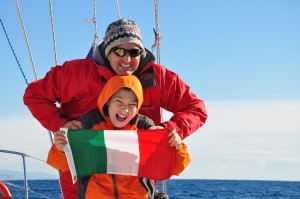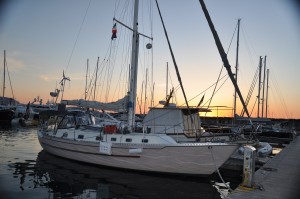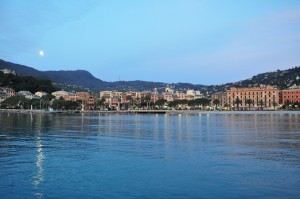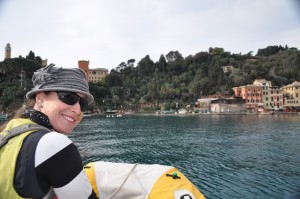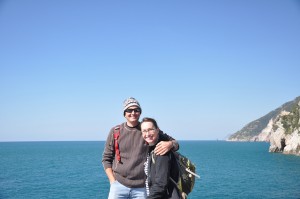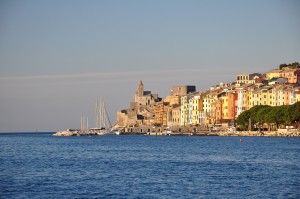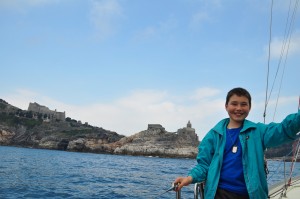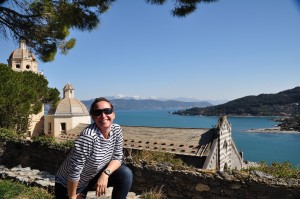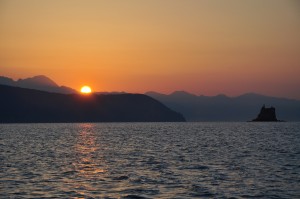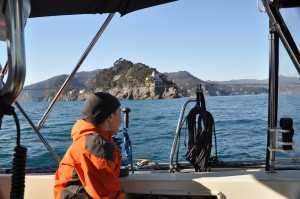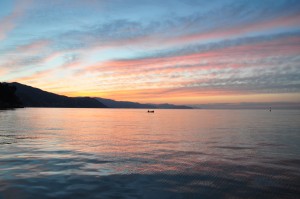We left Villefrance-sur-mer, France and made our way to Italy. Our first stop was Imperia in an anchorage so rolly that we had to brace ourselves while sleeping, lest we fall out of bed. Imagine the racket your house would make if it was rolling back and forth twenty degrees off center. Gah! The next day we sailed over to our next anchorage, which did not look promising. Remembering the previous night, we decided to take a pass. Plus, we were waiting for our weather window to cross the Gulf of Genoa and rationalized we needed our sleep.
The Gulf of Genoa, is like the little (and less dangerous) brother to the Gulf of Lyon. It is only 40 nautical miles across (from our crossing point), but you still need a good weather window to cross. So, instead of staying at an iffy anchorage, we decided to head into a marina in Loano and get a good night’s sleep (or two.) Sensible, right? It turns out the marina was high priced but gorgeous. As a bonus, the marina had floating docks with finger piers! This may not seem like a big deal, but typically marinas in the Mediterranean are concrete docks. They don’t float because there is a negligible tidal fluctuation. Most boats pull up to the dock “stern to,” but in our case we have to go in “bow to” due to the fact that we have so much hanging off the stern and because it’s a canoe (rounded) stern and we wouldn’t be able to climb over all of that to get onto the dock. As it is, when we are “bow to” we have to climb over the bow to get on the dock. Depending on how high or low the dock is determines how much gymnastics need to be performed to get over the pulpit and onto the dock. However, with finger piers, all we have to do is slide on up to the dock, tie the bow, spring and stern lines on one side to the dock. We don’t need help from dockhands, and disembarking is a lot easier.
The rest of the marina was just beautiful. It had a gorgeous yacht club, stylish (and clean) bathrooms, a large laundromat and walking distance into the old city center of Loano. High marks on all the items we need at a marina. We were in heaven. Loano is in the region of Liguria, known for its pesto sauce (among other things.) I took a provisioning trip into a small grocery store and found inexpensive hunks of aged parmesean, mozerella di buffalo, handmade pasta, fresh bread and a small but beautiful selection of fruits and vegetables. This grocery store was not much bigger than a 7/11 back in the U.S. but its pasta aisle was big enough that I could identify at least a dozen different types of pasta I’d never even heard of before. And that was just the section of dried pasta! Of course, they also sold fresh pasta and also fresh pesto sauce. Aaahhh, Italy…. All of my very favorite foods, but instead of finding them in the “gourmet” section, it’s just regular grocery fare.
That night we went out to dinner at a small trattoria and had a delicious meal of pesto pasta, bread and wine. In Loano they serve pesto with linguine and pieces of green beans and potato. Trust me, it’s delicious. Later as we walked around the old city center, we could imagine what Loano would have been like hundreds of years ago with its small, winding streets too narrow for cars, its medieval churches and the multi-colored houses. We ended up staying in Loano for 5 nights, waiting for our weather window. We had a weather system pass through and got winds over 40 knots in the marina during that time. However, while idle, we got a lot of work done on the boat including waxing the hull, polishing all the stainless steel (inside and out). After all, we are in Italy and people take pride in looking good. There may not be any hope for us, but Benevento can still be polished up.
We left early the morning of our 10- hour crossing of the Gulf of Genoa. The weather forecast called for 5 knots of wind so we expected to motor across and end up at an anchorage in Portofino. Unfortunately, instead of 5 knots we had wind up to 35 knots. At first I was angry because we were getting salt water all over our newly washed, waxed and polished girl!! Then I was angry (and, admittedly scared) because it was simply no fun to be in those conditions. You start to wonder, “If the forecast is this wrong, will it get worse? Will we be in a bad situation out here? Will we not get across before nightfall? Will it be worse on the other side?” It was cold and grey, which didn’t add to my feeling of well-being. One good thing was that the wind was coming from the land, which meant that the waves had little time to build over the gulf (versus if the wind was coming from the other direction across the Mediterranean.) So despite the high winds, the waves were only around 5 feet. Fortunately the last third of the crossing the wind and seas started to ease a little. We knew that the worst was over.
I hate every minute of those kinds of passages and conditions – but when we set anchor in a beautiful and calm location it’s almost as if I completely forget that we were in them. Around 3pm we motored around the point into Portofino. It was a very surreal moment to see that town from the water in our own boat. 15 years earlier Darold and I had been there on our honeymoon and he told me that someday we’d sail back in our own boat. Of course I didn’t actually believe him. We didn’t even own a boat at the time! Little did I know… The anchorage at Portofino didn’t look secure enough if we had any sort of weather come in so we decided instead to motor another mile and a half over to Santa Margherita di Ligure to a larger and more secure anchorage. Gorgeous! It all seems to even out. If you don’t pay the price of admission, you don’t get the rewards.
We spent one day exploring beautiful Santa Margherita and the following day exploring Portofino. Even though we are sailing in the Mediterranean during winter (and in the windiest part of the Med), the upside is that there are no other cruisers, and very few other tourists around. It may be cold, but usually we are the only boat in prime anchorages. So what we’re sleeping in three layers of clothes! We left our anchorage to make our way down the Cinque Terre coast. We first stopped in Sestri Levante in another wonderfully calm anchorage. We took the dinghy into town and found a trattoria off the beaten path where Dante had his first real Italian pizza. (“I get a whole pizza to myself? But wait, I have to eat it with a knife and fork?”) We told the chef that it was Dante’s first, and he apologized and told us in Italian, “I’m so sorry that this is your first Italian pizza, because all other pizzas you have will not be as good. Me despeace.”
Afterwards we took a walk on the beach and scoured for sea glass. We also found a lot of broken bits of colored tile. Only in Italy will you find “sea tile”, little pieces of colored tile rounded at the edges from being pounded in the surf. It’s interesting to think how old the tile must be and where it came from.
The next day we sailed down the coast, intending to anchor off one of the towns of Cinque Terre. However, as we passed them it was clear that all of the anchorages would be open and very rolly. We decided instead to head towards the Gulf of Spezia. There were a number of anchoring options inside the gulf. As we approached the point, there was an imposing (but beautiful) castle and church, which led us into a passage between the point and an island. As we rounded the point we saw the beautiful town of Portovenere, and saw that there was a well-protected anchorage just outside the town. Voila! Again, we were the only boat in this lovely and well-protected anchorage. The next day we took the dinghy into town to explore the churches, the castle and the beautiful town. We went to lunch at a trattoria and had pesto with the local pasta called “trofie”, which are small twisted pieces of pasta. It’s interesting how the same ingredients in pasta can taste so different just based on the shape. God, I love Italy.
The following day we circumnavigated the small island off of Portovenere (Isola Palmaria) in our dinghy and entered into the island’s “Grotto Azure” (blue grotto). Not as famous as the one on the island of Capri, but really cool nonetheless. The next day we took the dinghy three miles over to the larger town of La Spezia. We tied up at the public dock, ran errands and had lunch then headed back to the dinghy. Unfortunately, the dinghy engine died shortly after starting and would start again. Darold tried to fix it at the dock, but to no avail. With nighttime approaching, we decided to start heading back to the boat – by rowing. Three miles of rowing took us (err…Darold) about 2 hours. By the time we were back to Benevento it was totally dark and Darold had some sore shoulders.
We were supposed to spend the following day relaxing prior to our 10 hour passage to Cala de Medici (near Livorno.) However, upon trying to heat up water for showers we noticed that the water heater wasn’t working. So Darold spent the day fixing the water heater and the dinghy engine. So much for relaxing… We motored the next day (all day) to an anchorage outside the harbor of Viareggio, and then continued the next day to Cala de Medici. We were in Tuscany, but under its clouds and rain instead of the sun. Oh well, at least we were in Tuscany.
For all of our pictures of Liguria, including Cinque Terre, go to our Flickr page: https://www.flickr.com/photos/easethemain/sets/
